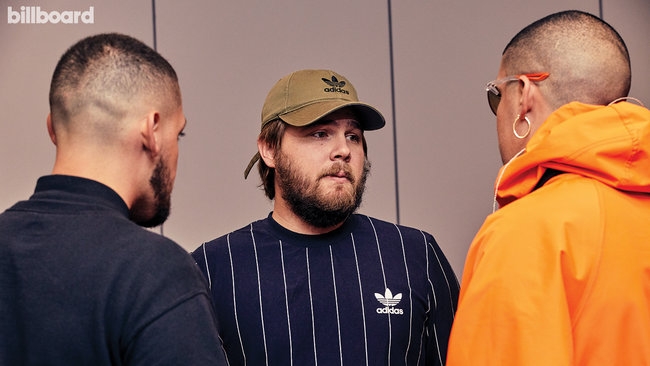When Noah Assad launched Rimas Entertainment in 2014, he was 24 years old but already well-known in Puerto Rico’s urban scene, having booked shows for the likes of reggaetón duo Jowell & Randy. Co-founded with José “Junior” Carabaño, then 20, Rimas began as a YouTube multichannel network that distributed and marketed artists’ videos and music, enabling it to optimize, prioritize and monetize their content on the platform. But Assad also wanted to sign artists and develop a bona fide label with a management arm.
That’s where his head was at in 2016, when a friend played him a SoundCloud track called “Diles” by a trap artist named Bad Bunny. “And I said, ‘Just because of the name I want to meet him,’” recalls Assad. He watched Bad Bunny perform at Las Justas, an annual college sports tournament in Puerto Rico, and immediately recognized an “it” factor, coupled with an already well-developed, unique sound and look. “We had signed a couple of artists before Benito [Martinez Ocasio, Bad Bunny’s real name]. But Benito is an amazing case. And he just blew up.”
Back then, Latin trap was still underground -- mostly confined to Puerto Rico, with lyrics too raunchy for mass consumption. But Assad saw the reaction Bad Bunny elicited from the college crowd, and he envisioned a new approach to distribution harnessing the power of YouTube and streaming platforms. He would release Bad Bunny’s singles at a furious clip -- a stark departure from Latin acts of even three years prior -- with the artist recording music “literally every day.” And he would make videos (ultimately, for roughly half of those songs) on the cheap, most for under $10,000, sometimes even less than $5,000. “You can’t have the same impact without the video,” says Assad. “When he came out, that was everything.”
Rimas is among a growing number of savvy independent distributors gaining new prominence in the Latin market -- and challenging its traditional label structure -- by pairing with rising stars and acting as their rights managers, revenue collectors and labels, often funding and marketing their music videos, too. Outfits like Rimas, ONErpm, Inner Cat and Symphonic Distribution have accelerated the release cycle, focusing on singles and videos rather than albums -- a shift that’s particularly crucial for the Latin genre. According to the RIAA, by midyear 2018 streaming accounted for 91 percent of all U.S. Latin music consumption, compared with 75 percent for the market overall.
Last year, for example, label, distributor and rights manager Cinq Music partnered with Rhythm Nation Records to record and distribute Janet Jackson’s new material, including her single with Daddy Yankee, “Made for Now.” Glad Empire releases trap star Anuel AA’s music. And in Bad Bunny’s case, Rimas acts as both his label and digital distributor, sometimes partnering with other distributors for certain projects (as it did with the Orchard for the digital-only release of X100PRE). To date, Bad Bunny has recorded over 100 singles and filmed over 50 videos, and although many of those involved other artists, the clips on his YouTube channel are his own creations.
Assad won’t reveal precisely how Rimas optimizes the YouTube algorithm to send Bad Bunny’s YouTube views into the hundreds of millions, but he says “we figured out a way to market each piece of content,” mining data like a guest artist’s fan-base demographics, or encouraging collaborations with local acts that are trending on social media. Everything that is uploaded “has to have a strategy.”
Already, Assad has focused on the next industry sector to disrupt: publishing. Rimas acts as an indie label for 14 artists as well as a digital marketer and distributor for high-profile releases from artists like Ozuna and Maluma. Assad has also now signed over 40 songwriters. “Anyone can do music, anyone can do a video,” he says. “There are a lot of multichannel networks out there. But it’s always about creating unique content.”
This article originally appeared in the Feb. 16 issue of Billboard.





